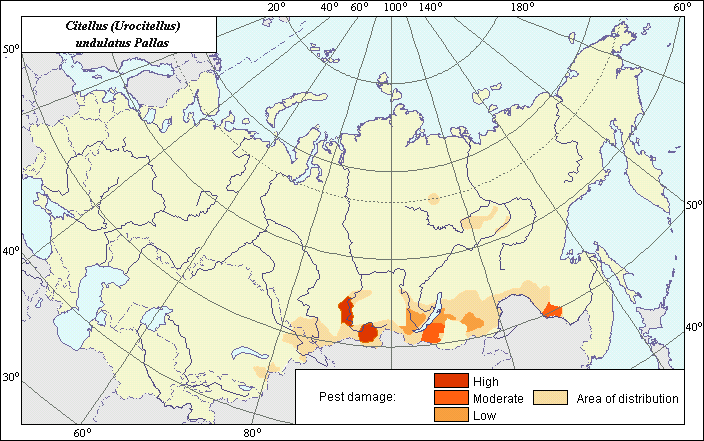Pests
The area and zones of harm for the Long-Tailed Ground Squirrel, Citellus undulatus Pallas 1778
 Object description Download GIS-layers
Object description Download GIS-layers
Authors:
Specialist-biologist A.F. KarlikGIS-specialist M.I. Saulich
Date of creation:
16.07.2003Scale:
1:20,000,000.Accuracy of map:
Map was created using maps of natural scales 1:11,000,000, 1:40,000,000, and 1:70,000,000 and according to information drawn from published sources.Projection:
"Alber's Equal Area Conic for the USSR", 9, 1001, 7, 100, 0, 44, 68, 0, 0.Basic content:
Vector map consists of 4 layers. The distribution area and zones of harm are shown by polygons.Accuracy of classifier:
The geographic area within the range of the natural habitat is divided into 3 zones of harm (high, moderate, and low). Zone of high harm includes agricultural lands with a rodent population density (on average) of 10-50 inhabited holes per 1 ha; zone of moderate harm includes agricultural lands with a rodent population density (on average) of 3-5 (up to 50) inhabited holes per 1 ha; zone of low harm includes agricultural lands with a rodent population density (on average) of 1 to 10-15 inhabited holes per 1 ha.Mapping procedure:
Area of species distribution was determined using the map from "Mammals of the USSR" (Moscow, 1970) and correctioned according to a map by Mezhova & Frisman (1984) with the help of electronic publications on the Long-Tailed Ground Squirrel (Shilova & Savinetskaya, 2003). Zones of harm were allocated according to methodical guidelines outlined in "Distribution of main pests on crops in the USSR and efficiency of pest control" (Leningrad, 1975). The latest reports about the Long-Tailed Ground Squirrel population variability and harmfulness in Yakutia (Solomonov et al., 2003) were also taken into account. Maps were scanned. Registration and vectorization of raster maps was executed using standard GIS technologies.Sources of data:
Distribution of main pests on crops in the USSR and efficiency of pest control: Methodical guidelines. 1975. Leningrad: VASHNIL, VIZR. 66 pp. (in Russian).Flint V.E., Chugunov U.D., Smirin V.M. 1970. Mammals of the USSR. Moscow, Mysl. 473 pp. (in Russian).
Mezhova O.N., Frisman L.V. 1984. Cadastral-reference map of area of Long-tailed Ground Squirrel Citellus undulatus Pallas (1778) (Rodentia, Sciuridae). Voprosy izmenchivosti i zoogeogafii mlekopitayushchikh. 55-57 pp. (in Russian).
Shilova S.A., Savinetskaya L.E. 2003. Center of conservation of wild nature "Rodents of the former USSR". ( http://www.biodiversity.ru/programs/rodent/species.html )
Solomonov N.G., Anufriev A.I., Sedalishchev V.T. 2003. About reasons of population reduction of Long-tailed Ground Squirrel Citellus undulates in Yakutia. ( http://www.sevin.ru/menues1/index_rus.html/agreements/teriofauna/331-340.html )

